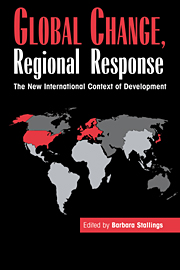Book contents
- Frontmatter
- Contents
- List of tables and figures
- List of contributors
- Acknowledgments
- Abbreviations
- 1 Introduction: global change, regional response
- Part I Global changes
- 2 The third world and the end of the cold war
- 3 Capitalisms in conflict? The United States, Europe, and Japan in the post–cold war world
- 4 Global production systems and third world development
- 5 New global financial trends: implications for development
- 6 The “triumph” of liberal economic ideas in the developing world
- Part II Regional responses
- Part III Conclusions
- Index
3 - Capitalisms in conflict? The United States, Europe, and Japan in the post–cold war world
Published online by Cambridge University Press: 05 June 2012
- Frontmatter
- Contents
- List of tables and figures
- List of contributors
- Acknowledgments
- Abbreviations
- 1 Introduction: global change, regional response
- Part I Global changes
- 2 The third world and the end of the cold war
- 3 Capitalisms in conflict? The United States, Europe, and Japan in the post–cold war world
- 4 Global production systems and third world development
- 5 New global financial trends: implications for development
- 6 The “triumph” of liberal economic ideas in the developing world
- Part II Regional responses
- Part III Conclusions
- Index
Summary
The end of the cold war and the disappearance of socialism as a major political-economic force opened the way for important changes in the capitalist world. These changes were of at least two types. On the one hand, the cessation of cold war hostilities between the United States and the Soviet Union downgraded the role of military in favor of economic power. This shift, in turn, increased the international standing of Europe and Japan at the expense of the United States, since the former are much stronger economically than militarily. On the other hand, the disappearance of socialism as an economic system focused attention on the differences among models of capitalism. In the 1990s, much more heed is being paid to variations in the ways of doing business in the United States, Europe, and Japan. While neither of these trends is totally new, the changed international panorama since the fall of the Berlin Wall greatly increased their salience.
For theorists and practitioners alike, a major question concerns the characteristics of the post–cold war international political economy. At the macro structural level, debate centers on whether the emerging system will be a multilateral, interdependent one, with close cooperation among capitalist powers, or a regionalized one consisting of trade and investment “blocs” in North America, Europe, and Asia. Our argument is that both of these processes are happening and will continue to do so. This simultaneity, which we call “nonhegemonic interdependence,” results in an unstable situation.
- Type
- Chapter
- Information
- Global Change, Regional ResponseThe New International Context of Development, pp. 67 - 99Publisher: Cambridge University PressPrint publication year: 1995
- 11
- Cited by



